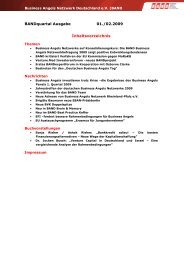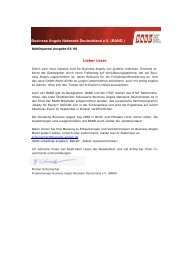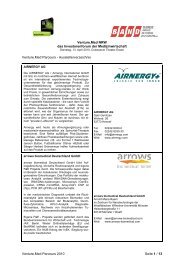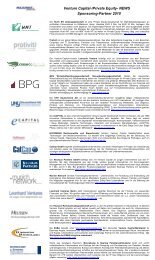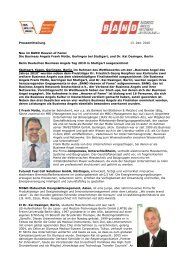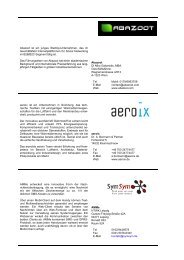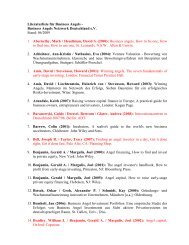The Discipline of Teams
The Discipline of Teams
The Discipline of Teams
Create successful ePaper yourself
Turn your PDF publications into a flip-book with our unique Google optimized e-Paper software.
BEST OF HBR 1993<br />
July-August 2005<br />
Product 4428<br />
<strong>The</strong> <strong>Discipline</strong> <strong>of</strong> <strong>Teams</strong><br />
What makes the difference between a team that performs and one that doesn’t?<br />
by Jon R. Katzenbach and Douglas K. Smith<br />
It won’t surprise anyone to find an article on teams by Jon Katzenbach and Douglas Smith figuring into an issue<br />
devoted to high performance. While Peter Drucker may have been the first to point out that a team-based<br />
organization can be highly effective, Katzenbach and Smith’s work made it possible for companies to implement<br />
the idea.<br />
In this groundbreaking 1993 article, the authors say that if managers want to make better decisions about teams,<br />
they must be clear about what a team is. <strong>The</strong>y define a team as “a small number <strong>of</strong> people with complementary<br />
skills who are committed to a common purpose, set <strong>of</strong> performance goals, and approach for which they hold<br />
themselves mutually accountable.” That definition lays down the discipline that teams must share to be effective.<br />
Katzenbach and Smith discuss the four elements—common commitment and purpose, performance goals,<br />
complementary skills, and mutual accountability—that make teams function. <strong>The</strong>y also classify teams into three<br />
varieties—teams that recommend things, teams that make or do things, and teams that run things—and describe<br />
how each type faces different challenges.<br />
Early in the 1980s, Bill Greenwood and a small band <strong>of</strong> rebel railroaders took on most <strong>of</strong> the top management <strong>of</strong><br />
Burlington Northern and created a multibillion-dollar business in “piggybacking” rail services despite widespread<br />
resistance, even resentment, within the company. <strong>The</strong> Medical Products Group at Hewlett-Packard owes most <strong>of</strong><br />
its leading performance to the remarkable efforts <strong>of</strong> Dean Morton, Lew Platt, Ben Holmes, Dick Alberding, and a<br />
handful <strong>of</strong> their colleagues who revitalized a health care business that most others had written <strong>of</strong>f. At Knight<br />
Ridder, Jim Batten’s “customer obsession” vision took root at the Tallahassee Democrat when 14 frontline<br />
enthusiasts turned a charter to eliminate errors into a mission <strong>of</strong> major change and took the entire paper along<br />
with them.<br />
Such are the stories and the work <strong>of</strong> teams—real teams that perform, not amorphous groups that we call teams<br />
because we think that the label is motivating and energizing. <strong>The</strong> difference between teams that perform and<br />
other groups that don’t is a subject to which most <strong>of</strong> us pay far too little attention. Part <strong>of</strong> the problem is that<br />
“team” is a word and concept so familiar to everyone. (See the exhibit “Not All Groups Are <strong>Teams</strong>: How to Tell the<br />
Difference.”)<br />
Executive summary Not All Groups Are <strong>Teams</strong><br />
Groups don’t become teams just because that is what someone calls them. Nor do teamwork values alone ensure<br />
team performance. So what is a team? How can managers know when the team option makes sense, and what<br />
can they do to ensure team success? In this groundbreaking 1993 article, authors Jon Katzenbach and Douglas<br />
Smith answer these questions and outline the discipline that defines a real team.<br />
<strong>The</strong> essence <strong>of</strong> a team is shared commitment. Without it, groups perform as individuals; with it, they become a<br />
powerful unit <strong>of</strong> collective performance. <strong>The</strong> best teams invest a tremendous amount <strong>of</strong> time shaping a purpose<br />
that they can own. <strong>The</strong>y also translate their purpose into specific performance goals. And members <strong>of</strong> successful<br />
teams pitch in and become accountable with and to their teammates.<br />
<strong>The</strong> fundamental distinction between teams and other forms <strong>of</strong> working groups turns on performance. A working<br />
group relies on the individual contributions <strong>of</strong> its members for collective performance. But a team strives for<br />
something greater than its members could achieve individually: An effective team is always worth more than the<br />
sum <strong>of</strong> its parts.<br />
<strong>The</strong> authors identify three kinds <strong>of</strong> teams: those that recommend things—task forces or project groups; those that<br />
make or do things—manufacturing, operations, or marketing groups; and those that run things—groups that<br />
oversee some significant functional activity. For managers, the key is knowing where in the organization these<br />
teams should be encouraged. Managers who can foster team development in the right place at the right time<br />
prime their organizations for top performance.
Not All Groups Are <strong>Teams</strong>: How to Tell the Difference<br />
Or at least that’s what we thought when we set out to do research for our book <strong>The</strong> Wisdom <strong>of</strong> <strong>Teams</strong><br />
(HarperBusiness, 1993). We wanted to discover what differentiates various levels <strong>of</strong> team performance, where<br />
and how teams work best, and what top management can do to enhance their effectiveness. We talked with<br />
hundreds <strong>of</strong> people on more than 50 different teams in 30 companies and beyond, from Motorola and Hewlett-<br />
Packard to Operation Desert Storm and the Girl Scouts.<br />
We found that there is a basic discipline that makes teams work. We also found that teams and good<br />
performance are inseparable: You cannot have one without the other. But people use the word “team” so loosely<br />
that it gets in the way <strong>of</strong> learning and applying the discipline that leads to good performance. For managers to<br />
make better decisions about whether, when, or how to encourage and use teams, it is important to be more<br />
precise about what a team is and what it isn’t.<br />
Most executives advocate teamwork. And they should. Teamwork represents a set <strong>of</strong> values that encourage<br />
listening and responding constructively to views expressed by others, giving others the benefit <strong>of</strong> the doubt,<br />
providing support, and recognizing the interests and achievements <strong>of</strong> others. Such values help teams perform,<br />
and they also promote individual performance as well as the performance <strong>of</strong> an entire organization. But teamwork<br />
values by themselves are not exclusive to teams, nor are they enough to ensure team performance. (See the<br />
sidebar “Building Team Performance.”)<br />
Building Team Performance<br />
Nor is a team just any group working together. Committees, councils, and task forces are not necessarily teams.<br />
Groups do not become teams simply because that is what someone calls them. <strong>The</strong> entire workforce <strong>of</strong> any large<br />
and complex organization is never a team, but think about how <strong>of</strong>ten that platitude is <strong>of</strong>fered up.<br />
To understand how teams deliver extra performance, we must distinguish between teams and other forms <strong>of</strong><br />
working groups. That distinction turns on performance results. A working group’s performance is a function <strong>of</strong><br />
what its members do as individuals. A team’s performance includes both individual results and what we call<br />
“collective work products.” A collective work product is what two or more members must work on together, such<br />
as interviews, sur-veys, or experiments. Whatever it is, a collective work product reflects the joint, real contribution<br />
<strong>of</strong> team members.<br />
Working groups are both prevalent and effective in large organizations where individual accountability is most<br />
important. <strong>The</strong> best working groups come together to share information, perspectives, and insights; to make<br />
decisions that help each person do his or her job better; and to reinforce individual performance standards. But<br />
the focus is always on individual goals and accountabilities. Working-group members don’t take responsibility for<br />
results other than their own. Nor do they try to develop incremental performance contributions requiring the<br />
combined work <strong>of</strong> two or more members.<br />
<strong>The</strong> Authors<br />
Jon R. Katzenbach is a founder and senior partner <strong>of</strong> Katzenbach Partners, a strategic and organizational<br />
consulting firm, and a former director <strong>of</strong> McKinsey & Company. His most recent book is Why Pride Matters<br />
More Than Money: <strong>The</strong> Power <strong>of</strong> the World’s Greatest Motivational Force (Crown Business, 2003). Douglas<br />
K. Smith is an organizational consultant and a former partner at McKinsey & Company. His most recent<br />
book is On Value and Values: Thinking Differently About We in an Age <strong>of</strong> Me (Financial Times Prentice Hall,<br />
2004).<br />
Der vollständige Artikel kann unter folgendem Link bestellt werden:<br />
http://harvardbusinessonline.hbsp.harvard.edu/b02/en/common/item_detail.jhtml?referral=7855&id=R<br />
0507P&_requestid=10889





